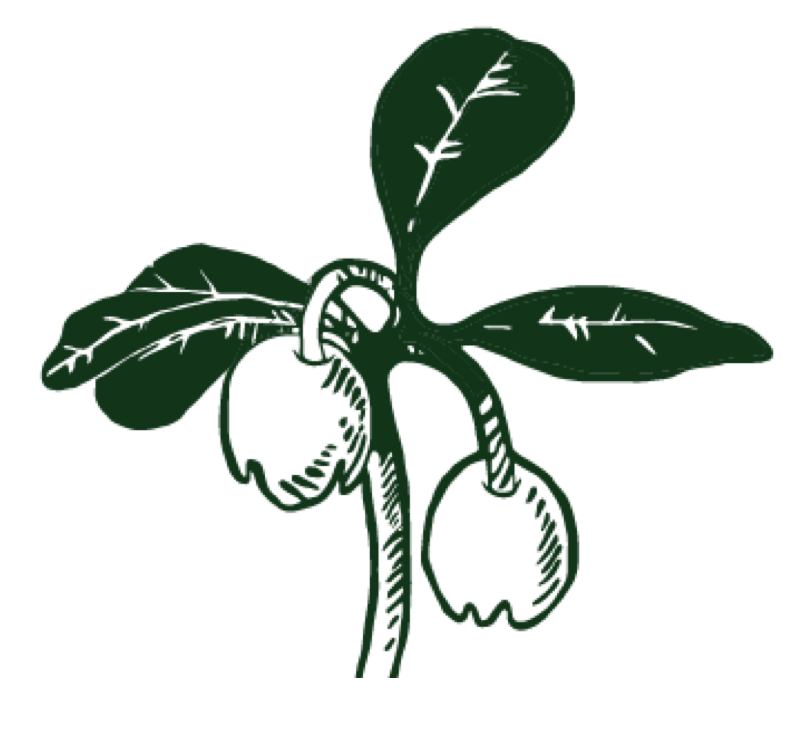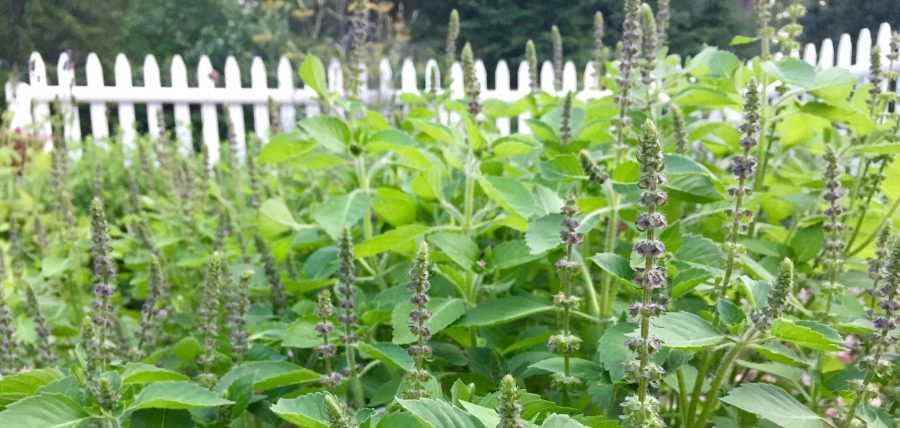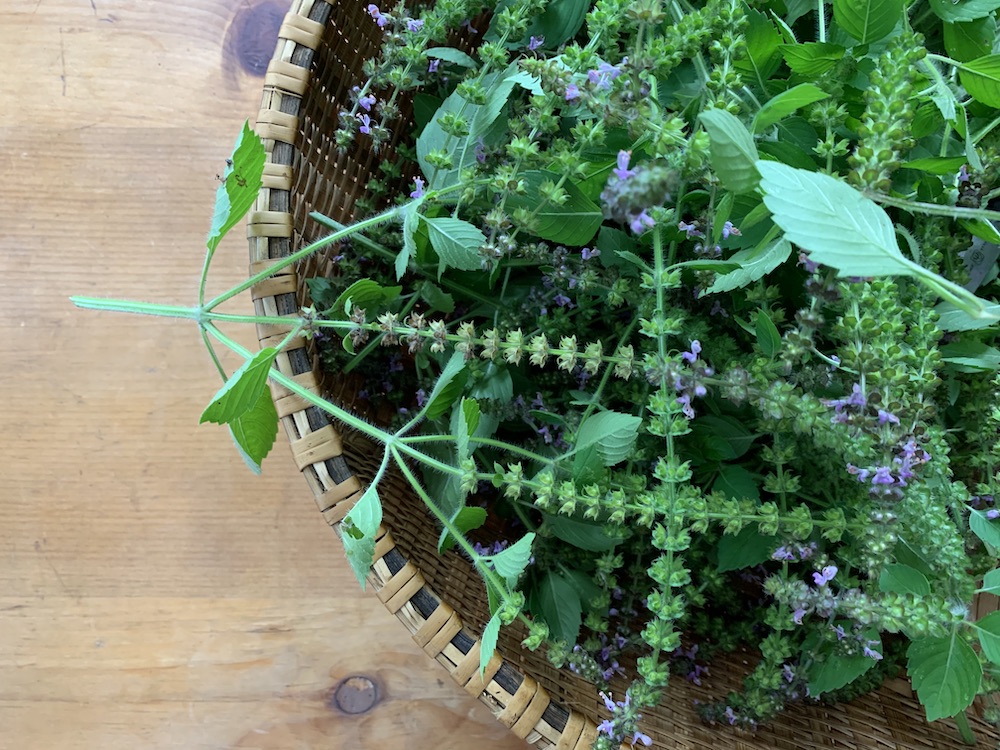Student Monograph ~
Holy Basil ~ Tulsi ~ Sacred Basil
This Materia Medica assignment (new, more in-depth style) was written by Diana Barkelew
with additional input from Maria Noel Groves and Ruth Droescher (RD).
Latin Name: It's complicated! Several different species and varieties of basil (Ocimum) are referred to as Holy Basil, Sacred Basil, or Tulsi, with slightly different though somewhat interchangeable benefits. The Latin names are a bit of a mess, with some names changing, and many plants being inaccurately labled as one species or another.
- Ocimum tenuiflorum, also called Ocimum sanctum (older name but still in common use)- many varieties of this species are enjoyed as Tulsi: krishna, rama, and amarita tulsi varieties
- Ocimum gratissimum: vana tulsi
- Ocimum x africanum: kapoor or temperate tulsi - this is the type that's easiest to grow in the United States and most often sold as Tulsi/Sacred Basil/Holy Basil seeds or seedlings, often mis-labeled as O. sanctum or O. teniflorum. Confusing matters, there are also other varieties of O. africanum that are known as lemon, hoary, and Thai, and/or Lao basil, which are a bit different from the temperate/kapoor Tulsi and generally have a more lemony aroma. Although O. africanum varieties are considered a hybrid of other basil species, Tulsi Kapoor does grow true to seed. There is some debate in the herbal and botanicals communities on the true identity and lineage of this species. There may be even more nuance learned with time! (MNG)
Note that our typical culinary and Italian basil plants hold only some but not all of the same medicinal properties as the tulsi/holy basil group. Other basil species are also popular throughout Africa, Central and South America, and the world.
For a deeper discussion of holy basil varieties, check out Richo Cech's blog post and video here (MNG).
Plant Family: Lamiaceae (mint family) (1)(2)
Part(s) Used: leaves and flowers (1) aerial in flower (2)
Flavor: Pungent, bitter (1) (3) Sweet, astringent (3) a bit spicy too (RD), notes of clove as well as bubblegum and mint (MNG)
Energetics: warming and drying (1) warming and cooling (3) Yep – ask 3 herbalists and get 5 different response….. (RD)
Identification/Growth/Habitat: Speaking generally of the various species and varieties of tulsi, these are shrubby to herbacious plant growing to a height of 3 feet, oval leaves with serrated edges are green or green to purple (depending on variety) arranged in opposite pairs on a hairy stem. Blooms are white to purple. When crushed, the leaves emit a spicy or clove/pepper fragrance (RD). In the mint family native to South Asia, India, and Africa, also growing in the warmer Americas. Most are perennial in South Asia and warmer climates, however is not frost tolerant so is an annual in cooler climates. Will grow in sun or partial shade and spreads easily given the room and rich moist soil. (3, MNG)
Maria Noel Groves grows and works almost exclusively with the O. africanum tulsi because it's delightful and so productive in the garden. This plant originates from Ethiopia in Africa and has green to greyish green leaves and stems and light greyish purple-pink flowers. It will self seed in some gardens. It has red pollen and notes of vanilla, clove, bubble gum, myrrh, and bisabolene aromatics (MNG, 10).
Key Actions: tonic (adaptogen, nervine, antioxidant, immunomodulant) antimicrobial, alterative, anticancer, antidepressant, antifungal, antispasmodic, anxiolytic, carminative, decongestant, expectorant, emmenagogue, radioprotective, tonic, stimulant (3) Also hypoglycemic (RD)
Medicinal Uses:
There are so many medicinal uses for Tulsi/Holy Basil that one could almost write a book about it.
Since 2007 there have been more than 100 scientific studies on Tulsi. “In vitro studies suggest that tulsi leaf has adaptogenic, metabolic, immunomodulatory, antitumor, anti-inflammatory, antioxidant, hepatoprotective, radioprotective, antimicrobial, anticonvulsant, anxiolytic, and antidiabetic properties. In vivo, tulsi preparations have been shown to have anti-stress effects and to protect rats from stress-related cardiovascular changes.” (4) This cited study is of the use of Tulsi as a single herb agent in human clinical trials. “The authors concluded that the reviewed studies “suggest that tulsi is a safe herbal intervention that may assist in normalizing glucose, blood pressure and lipid profiles, and dealing with psychological and immunological stress.” Tulsi’s effectiveness across diverse clinical domains suggests an adaptogenic effect. The Ayurvedic tradition of consuming tulsi daily (either on an acute or a chronic basis) may be an effective lifestyle measure to combat stress-related chronic illnesses.” (4)
Holy Basil is useful for stress and anxiety, it can reduce general anxiety and many symptoms associated with stress such as forgetfulness and sleep problems. Final observations of one study where 35 patients were given 500 mg of holy basil twice daily after meals showed that holy basil positively affected general anxiety levels as well as the stress and depression associated with anxiety. (1) Yes – it’s probably the first calming adaptogen most herbalists think of (RD).
As a nervine Tulsi is both stimulating and relaxing to the brain. Tulsi works to move stuck energy which helps ease hyperactivity and the inability to concentrate. Herbalist David Winston refers to holy basil as a cerebral stimulant. When used in formula with other cerebral stimulants such as rosemary, bacopa, and ginkgo, Tulsi/Holy Basil can help with menopausal cloudy thinking, poor memory, ADD and ADHD, and to speed up recovery from head trauma. The moving of stuck energy can also help with depression creating better communication and emotional expression with others. (1) (3)
There have been numerous clinical trials for the use of Tulsi/Holy Basil for insulin resistance and type 2 diabetes. Results of one study of 27 patients with non-insulin-dependent type 2 diabetes showed significant lowering of blood glucose, total cholesterol, low-and very low density lipoprotein-cholesterol and triglycerides. Taken daily, holy basil can help optimize cholesterol levels and lower stress-related high blood pressure. (1)
As an alterative, Tulsi has a cooling effect on the liver, bloodstream, and intestines and supports the elimination of toxins stored in body fats such as metals, medicinal drugs and compounds from cannabis use. (1) Also has diaphoretic properties, so can literally be “cooling” to the body (RD).
Tulsi is used by herbalist to help relieve stagnant digestion such as bloating, gas, decreased appetite, nausea, heartburn and to help heal ulcers. As with many mint family herbs, volatile oils in Tulsi produce warming antispasmodic and carminative actions that help soothe the digestive system. Herbalists also use Tulsi for lung problems such as bronchitis and pulmonary weakness, it can also be taken to prevent and treat upper respiratory viruses like the cold or flu. (1) (3) Preliminary research also indicates it can reduce the number of asthma attacks for those with chronic asthma (RD).
This herb is also effective in supporting the immune system. As an antimicrobial it can be used topically or internally to treat bacterial, viral, and fungal infections. (1) “A double-blind, randomized, controlled, cross-over clinical trial by Mondal et al. (2011) was conducted with 24 healthy volunteers to evaluate the immunomodulatory effects of tulsi leaf alcohol extract. The participants received 300 milligram capsules of tulsi extract or placebo. Statistically significant increases in immunological parameters (interferon-γ, interleukin-4, T-helper cells, and NK-4 cells) indicate that the leaf extract had an immunomodulatory role on healthy volunteers (Mondal et al., 2011)”. (3)
There is scientific evidence that Ocimum Sanctum Linn. (Tulsi) has therapeutic properties that have potential to prevent and treat cancer. NIH web site has several published articles that provide discussions of studies performed, see source (6) for one article on potential for cancer treatment and prevention. The articles do not provide information on recommended dosage and it appears that more human studies are needed, however the potential is exciting. In addition to guarding against cancer Tulsi is also used as support during chemotherapy and radiotherapy. “Preclinical studies have shown that tulsi “prevented chemical-induced skin, liver, oral, and lung cancers” (Baliga et al., 2013, Abstract)”. (3) Very promising and something to watch (RD).
There is also some similar scientific evidence that Ocimum Sanctum (Tulsi) could potentially inhibit the COVID-19 virus. The study also included Withania somnifera (Ashwagandha) and Tinospora cordifolia (Giloy). The study concluded that all three were predicted to be safe, drug-like compounds with no toxicity. Again, no dosage was cited and it appears that more human studies are needed. (5) Interesting – another one to monitor on this versatile herb (RD).
Other Uses:
Indian folk medicine and texts describe a poultice of Tulsi roots and leaves for use with snake bites, scorpion stings and insect bites and stings. (1) It does make a good insect repellant. And of course it’s common name refers to it being valued as a sacred herb, often planted around temples in India. It can also be used for culinary purposes. It does not taste like the Italian basil we are familiar with, but it can be used in stir fries salad dressings for a peppery note (RD).
Harvesting/Preparation/Dose: Harvest leaves and flowers mid-summer to fall, can harvest year round in milder climates. (3) Regular trimming of the top half of the flowers and leaves will keep the plant happy and produce more vital growth. (2) Can be used fresh or dried.
- Tea, decoction, tincture, fresh juice, poultice, powder, infusion in ghee or honey. (1) (2)
- Most common preparation is as a tea, start with 1 teaspoon to 2 cups by volume of the leaf and increase as desired. (1) (2)
- Tincture (fresh herb) 1:2, 75% alcohol, 3 to 5 mL 3x per day (1)
- Tincture (dried) 1:5 in 50-60 percent alcohol, 1-3 ml, 1-3 times daily, solo or in formula (2)
- Also the fresh herb a can be used as a poultice for skin irritation and even chronic pain. Also helps soothe the rash from poison ivy and reduce the itching (RD).
Personal Experience: I planted some Tulsi/Rama this year from seeds that I purchased from strictly medicinal, Ocimum tenuiflorum. I had the plants in the greenhouse and they were doing pretty good but growing slowly, then I set the pot outside and the leaves got sunburned so I moved it back to the greenhouse and am hoping that the plants will survive. Update, surviving but still growing slow. I planted a few in the garden, perhaps when the weather warms up they will take off! I tried some tea from dried herb in my kit from the class 2 tsp per 2 cups of water infused 10 minutes. It was slightly bitter so I added a teaspoon of the lemon balm honey I made for class 7 and then it was really yummy. I will try in other tea blends in the future as it appears to have many health benefits. I hope your plants do grow for you – the fresh herb makes a “brighter” flavored tea, and also tastes nice added to some seltzer with a splash of lemon juice and perhaps a mint leaf (RD).
Cautions:
If taking insulin to control diabetes approach with caution and adjust insulin levels with the aid of a health care provider. May have an antifertility effect on both men and women and should not be used regularly by pregnant women or couples wishing to conceive. Is slightly blood thinning and should not be taken with other blood thinners. (1) preliminary studies indicate Tulsi may speed up the elimination of some medications. (3)
Sources:
- 1. Alchemy of Herbs, Rosalee De La Foret, 2017 herbalist
- 2. Grow Your Own Herbal Remedies, Maria Noel Groves, 2019 herbalist
- 3. https://herbarium.theherbalacademy.com/monographs/#/monograph/3045, herbrarium monographs
- 4. Single-Ingredient Clinical Trials with Tulsi — Systematic Review of the Evidence - American Botanical Council, scientific
- 5. Shree P, Mishra P, Selvaraj C, Singh SK, Chaube R, Garg N, Tripathi YB. Targeting COVID-19 (SARS-CoV-2) main protease through active phytochemicals of ayurvedic medicinal plants - Withania somnifera(Ashwagandha), Tinospora cordifolia (Giloy) and Ocimum sanctum (Tulsi) - a molecular docking study. J Biomol Struct Dyn. 2020 Aug 27:1-14. doi: 10.1080/07391102.2020.1810778. Epub ahead of print. PMID: 32851919; PMCID: PMC7484581. Abstract https://pubmed.ncbi.nlm.nih.gov/32851919/ or full text at https://www.ncbi.nlm.nih.gov/pmc/articles/PMC7484581/ (scientific)
- 6. Bhattacharyya P, Bishayee A. Ocimum sanctum Linn. (Tulsi): an ethnomedicinal plant for the prevention and treatment of cancer. Anticancer Drugs. 2013 Aug;24(7):659-66. doi: 10.1097/CAD.0b013e328361aca1. PMID: 23629478. Abstract https://pubmed.ncbi.nlm.nih.gov/23629478/ scientific
Additional useful resources (MNG suggested):
- Rosalee de la Foret has some excellent monographs on tulsi in her book Alchemy of Herbs and her website https://www.herbalremediesadvice.org/health-benefits-of-tulsi.html
- Adaptogens book by David Winston & Stephen Maimes (particularly nice, thorough, easy to read and understand)
- Adaptogens book by Donald Yance (extremely thorough, lots of scientific detail)
- Tulsi Monograph by Kristal Thompson on HerbRally at https://www.herbrally.com/monographs/tulsi
- Tulsi Monograph by Gayle Engels and Josef Brinkmann in the American Botanical Council's HerbalGram at https://www.herbalgram.org/resources/herbalgram/issues/98/table-of-contents/hg98herbpro-holybasil/
- The Clinical Efficacy and Safety of Tulsi in Humans: A Systematic Review of the Literature. Jamshidi N, Cohen MM. Evid Based Complement Alternat Med. 2017;2017:9217567. doi: 10.1155/2017/9217567. Epub 2017 Mar 16. PMID: 28400848; PMCID: PMC5376420. Full Text: https://www.ncbi.nlm.nih.gov/pmc/articles/PMC5376420/
- Tulsi - Ocimum sanctum: A herb for all reasons. Cohen MM. J Ayurveda Integr Med. 2014 Oct-Dec;5(4):251-9. doi: 10.4103/0975-9476.146554. PMID: 25624701; PMCID: PMC4296439. Full text https://www.ncbi.nlm.nih.gov/pmc/articles/PMC4296439/
- Aisle7/Healthnotes has a brief scientific-minded overview write up on holy basil at https://www.goodfoodstore.com/Aisle7/Default.aspx?resource=%2fassets%2fnutritional-supplement%2fholy-basil%2f%7edefault
- It's mentioned in several books including those by Andrew Chevallier and Thomas Easley/Steven Horne and many others. Though since it's newer to western herbalism, most of your older American and European herbals don't include it. You will find references in herbal resources from India/Ayurveda and Africa since it has a long history of use in those places. This plant can be challenging to search for also because it has so many different common and Latin names.
- http://xochipelli.fr/2022/08/in-search-of-the-origins-of-the-temperate-tulsi-with-its-spicy-vanilla-and-myrrh-fragrance-and-its-red-pollen/
 Diana Barkelew has a passion for gardening and has enjoyed it for nearly 50 years. She feels fortunate to live in the Willamette Valley of Oregon where there is a long growing season and an abundance of wild herbs and mushrooms. She has been interested in herbal remedies for a long time, however working long hours and having a long commute left few hours to pursue her passion. She retired from accounting in December 2017 and was excited to start her herbal journey. She has a green house and starts most of her plants from seed or cuttings and has been expanding her herbal healing garden each year. She also enjoys foraging for the abundant stinging nettle, horse tail, and St John’s Wort that grows near her home. The first few years was all self-study with books from herbalists such as Rosemary Gladstar, Michael Moore, Michael Wood, and Maria Noel Groves. She just finished Wintergreen Botanicals Home Herbalist Series and will begin the Beyond the Home Herbalist Series soon. She hasn’t decided where this journey will take her. Once she has more experience, she is hoping to share her own herbal remedies with other seniors (people and animals) and those dealing with cancer. Her constant companion for almost 13 years is her Lab Suzie, who also accompanies Diana and her husband on many RV trips and to spend most winters in Arizona.
Diana Barkelew has a passion for gardening and has enjoyed it for nearly 50 years. She feels fortunate to live in the Willamette Valley of Oregon where there is a long growing season and an abundance of wild herbs and mushrooms. She has been interested in herbal remedies for a long time, however working long hours and having a long commute left few hours to pursue her passion. She retired from accounting in December 2017 and was excited to start her herbal journey. She has a green house and starts most of her plants from seed or cuttings and has been expanding her herbal healing garden each year. She also enjoys foraging for the abundant stinging nettle, horse tail, and St John’s Wort that grows near her home. The first few years was all self-study with books from herbalists such as Rosemary Gladstar, Michael Moore, Michael Wood, and Maria Noel Groves. She just finished Wintergreen Botanicals Home Herbalist Series and will begin the Beyond the Home Herbalist Series soon. She hasn’t decided where this journey will take her. Once she has more experience, she is hoping to share her own herbal remedies with other seniors (people and animals) and those dealing with cancer. Her constant companion for almost 13 years is her Lab Suzie, who also accompanies Diana and her husband on many RV trips and to spend most winters in Arizona.
Photographs of Tulsi Kapoor (O, africanum) by Maria Noel Groves in the Wintergreen Botanicals gardens in Allenstown, NH


